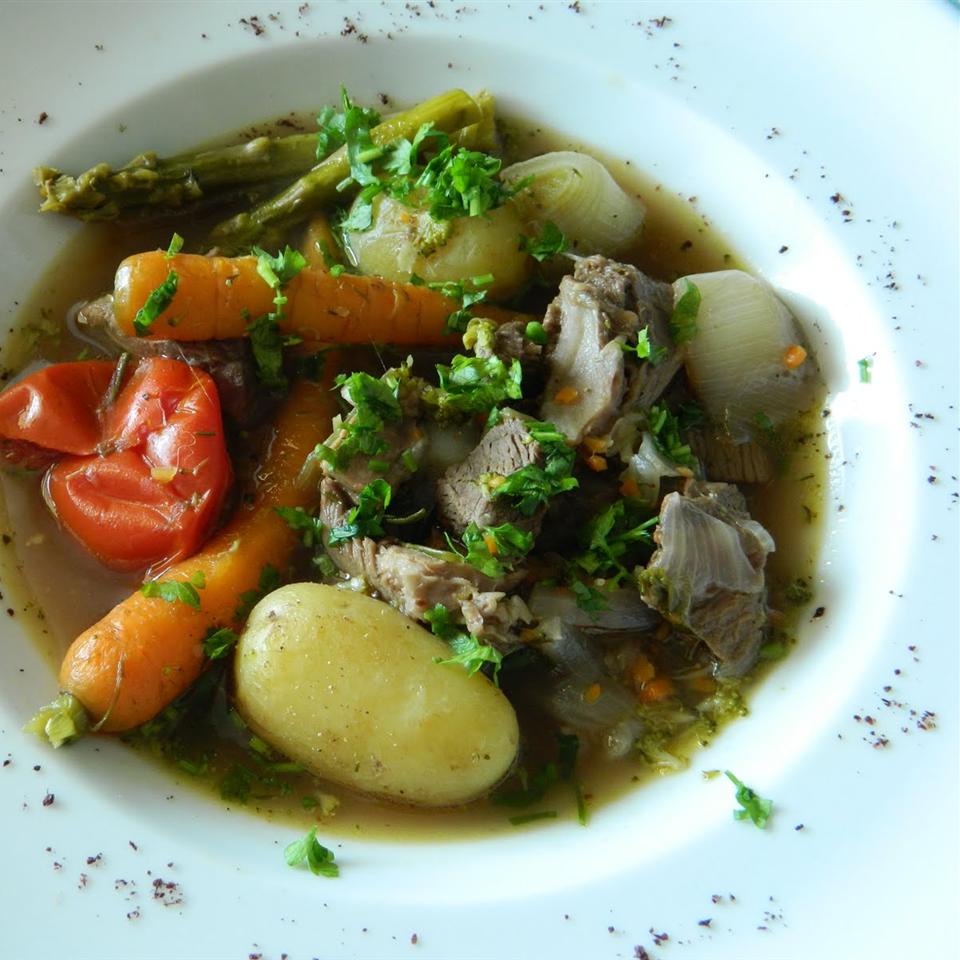Pot-au-Feu

The flavorful broth is often traditionally served first, dotted with croutons and sprinkled with Gruyère cheese. The main dish, or ‘bouilli’ - a platter of boiled meats and mixed vegetables - follows usually with gherkins and a variety of mustards, horseradish, and sauces alongside. The two courses can also be combined into one course. You can serve with more boiled carrots, leeks, parsnips, potatoes, and turnips, as well as boiled cabbage.
INGRIDIENT
DIRECTION
Step: 1
Pierce each whole onion with a clove. Place onions, 2 leeks, 2 carrots, 3 celery ribs, and garlic in a large pot. Set roast on top of the vegetables. Wrap parsley, thyme, and bay leaves in a moistened piece of cheesecloth and tie into a bundle. Add the cheesecloth bundle, salt, and peppercorns to the pot.
Step: 2
Pour beef stock over the roast and vegetables. Bring to a boil. Reduce heat to low. Cover partially and simmer, skimming occasionally, until roast is very tender, about 2 1/2 hours.
Step: 3
Transfer roast to a large bowl and cover. Strain broth, discarding solids, and return it to the pot. Boil over high heat until reduced to 8 cups, about 45 minutes. Skim off the fat.
Step: 4
Stir remaining 2 leeks, 2 carrots, and 3 ribs celery into the reduced stock. Add turnips, rutabagas, and parsnips. Cover and simmer over low heat until vegetables are just tender, about 30 minutes. Add potatoes. Cover and simmer until potatoes are tender, about 40 minutes more. Add sausage; simmer until heated through, 5 to 10 minutes. Season the broth with salt and pepper.
Step: 5
Slice the roast across the grain into 6 to 8 slices. Ladle the broth into shallow bowls. Plate roast, sausage, and vegetables on a separate platter.
NUTRITION FACT
Per Serving: 562 calories; protein 32.6g; carbohydrates 35.4g; fat 32.1g; cholesterol 90.1mg; sodium 1161.1mg.
The name of “stew” can refer to both a dish and a make dishes method. Stewing makes not fast cooking chunks of meat, raw fruit or beans in a flavorful liquid . It’s same as to braising, instead it does have a few notable differences. The meat is chopped into smaller pieces but of being processing menu whole , and the water based material all of it covers the contents in a stew as different to a braise’s halfway full . When meat or raw fruit are cooked using this method, the resulting dish is called stew.
Stew has a reputation for making a rib-sticking meal that warms you up on a cold , winter day. It’s true ; a bowl of old menu of beef stew does have warming properties , but stew’s cozy factor more than a way beyond protecting you from the chill . It’s all about those tender chunks of meat and vegetables, swimming in a thick, ultra-rich gravy. The more they come together creates the greatest comfort food, no matter the weather.





